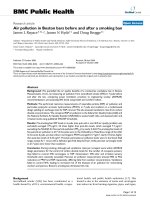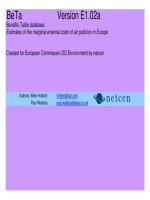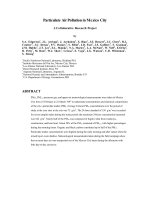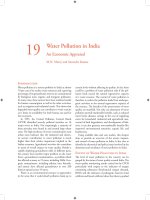STRATEGIES TO REDUCE AIR POLLUTION IN INDIA pdf
Bạn đang xem bản rút gọn của tài liệu. Xem và tải ngay bản đầy đủ của tài liệu tại đây (1021.54 KB, 74 trang )
STRATEGIES TO REDUCE
AIR POLLUTION IN INDIA
Dr. B. Sengupta
Dr. B. Sengupta
Former Member Secretary
Former Member Secretary
Central Pollution Control Board
Central Pollution Control Board
Ministry of Environment & Forests
Ministry of Environment & Forests
Govt. of India, Delhi
Govt. of India, Delhi
Email: ,
Paper presented at Indo-Japanese Conference on Fuel Quality and Vehicular Emissions
On 18 March , 2009
Contents
Contents
Air Quality Concerns
Current Status of AQM
Air Quality trends
Thrust Areas
Way Forward
3
METROS CITIES/URBAN AREAS
65 non-attainment cities
Dominant Sources: Vehicular Emissions, Small/Medium
Scale Industries, Gensets, Biomass burning, etc.
Pollutants: NO
x
, SPM/RSPM & CO
CRITICALLY POLLUTED AREAS
24 critically polluted areas
Dominant Sources: Industries-Power Plants, Refineries,
Chemical Plants, etc.)
Pollutants: NO
x ,
SPM/RSPM, SO
2
VOCs, PAHs, etc.
RURAL AREAS
Indoor air pollution: Use of Biomass, Coal, kerosene,
etc.
Outdoor air pollution: Unpaved roads, Biomass burning,
Gen-sets etc.
Pollutants: SPM/RSPM, CO, etc.
Air Quality
Concerns
A
ir
Q
ualit
y
Concerns
Current Status of AQM
Current Status of AQM
Institutional Mechanism
Assessment of Air Quality
Monitoring
Emission Inventory
Source Apportionment
Air Pollution Exposure & Health
Impacts
Control Strategies
City Specific AQM Action Plans
Institutional Mechanism
Institutional Mechanism
Central Level
Ministry of Environment & Forests
Central Pollution Control Board
Environment Pollution Control Authority
Ministry of Petroleum & Natural Gas
Ministry of Road Transport & Highways
Other Central Ministries/Agencies
R&D Centers & other Institutions
State Level
Department of Environment
Pollution Control Board/Committees
Local Bodies/Authorities
PAPER
1%
TPP
58%
OTHERS
0%
SUGAR
1%
CEMEN
T
40%
TPP
82%
OTHERS
1%
SUGAR
10%
CEMEN
T
7%
OIL
REFINERIE
S
3%
SULPHURIC
ACID
PLANTS
2%
STEEL
5%
TPP
89%
SPM LOAD FROM INDUSTRIES (T/DAY)
[Without Control Device]
SPM LOAD FROM INDUSTRIES (T/DAY)
[With Control Device]
SO
2
LOAD
FROM
INDUSTRIES
(T/DAY)
Emission Inventory
Emission Inventory
Emission Inventory (Contd )
Emission Inventory (Contd )
Air pollution from vehicles in Delhi
Air pollution from vehicles in Mumbai
Control Strategies
Adopted
Control Strategies
Adopted
Air Quality Standards notified (1982 & 1994) and Air
Pollution Control areas declared
Emission Standards notified for Industries Vehicles (in-use
& new), Gensets, etc.
Fuel quality improvements. (Coal, gasoline & diesel).
Relocation of polluting industries, phasing out older
polluting vehicles, introduction of mass rapid
transportation, etc.
Road map for control of emissions from new and in-use
vehicles developed up to year 2010
Use of Alternate fuel (CNG,LPG,Ethanol petrol, Bio-diesel,
Hydrogen,etc.)
1 % in NCT &
Mumbai
Feb
2000
Unleded
Country
5 %
April 1996
April 2000
3% in Metro cities
Nov. 2000
3 % in all India
&
1% in Major Metros
April. 2005
3 % in all India
April. 2010
June
1994
0.15 g/l
(4 metro)
April
1995
Unleaded
4 metros
Low leaded
Entire Country
Jan
1997
Jan
1999
Unleaded
NCR
Gasoline Benzen
e
Reduction
Pro
g
ramme in India
Gasoline Lead
Phase-out
Programme In
India
Before 1996
No Specifications
Vehicle Emission
Norm Schedule In
India
1990
1
st
set norms
notified
1995
Emission norms for
catalytic vehicles
1996
2
nd
set norms
notified
2000/01
Euro-I equivalent (Country)
Euro-II eqv. For cars (4 metros)
2005
Euro-II (Country)
Euro-III (11 cities)
2010
Euro-III (Country)
Euro-IV (11 cities)
August 1997
Sulphur 0.25%
Delhi & Taj
Sulphur 0.25%
Metro cities
April 1998
Sulphur 0.25%
Entire Country
April-2000
April 2000-04
Sulphur 0.05%
11 cities
April
April6
Sulphur 0.50 %
4 metros & Taj
Diesel Sulphur
Reduction
Programme
Sulphur 0.05%
Entire Country
& 0.035 (11 cities)
April-2005
April-2010
Sulphur 0.005% (11 cities)
& 0.035%
(Entire Country)
EMISSION
REDUCTIONS
ROAD MAP
FOR NEW
PASSENGER
CARS
EMISSION
REDUCTIO
NS ROAD
MAP FOR
NEW (HDV)
CREP developed for 17 categories of
industries
Specific control strategies for major
industries
Initiatives for small scale sector
City specific AQM action plans
Control Strategies Adopted
(contd )
Control Strategies Adopted
(contd )
THERMAL POWER PLANT:
Ash utilization time frame laid down
(26% utilization)
Enforcement of PM Emission
Standards (70% compliant)
Mandatory use of beneficiated coal
Promotion of clean coal technologies.
(FBC, PFBC, IGCC, etc.)
Tall stack dispersion
Industry Specific
Control Strategies
Industry Specific
Control Strategies
Air Pollution Due to Use of
Coal in Thermal Power Plants
Air Pollution Due to Use of
Coal in Thermal Power Plants
ITEMS EXISTING
SCENARIO
2050
SCENARIO
Coal based Electricity
Production
(MW)
67600 900000
Coal Consumption
(million tonnes)
258 3434
Particulate Matter
Emission (mil
lion tonnes)
1.62 21.9
Sulphur Dioxide
(million tonnes) Emission
2.451 32.6
Oxide of Nitrogen
(million tonnes)
2.3 30.9
Source: CEA/NTPC
Use of clean coal technologies (Super Critical ,IGCC, PFBC, CFBC, etc.)
to be promoted based on location specific requirements.
Oil Refineries
Control of SO
2
emissions by using high
efficiency SRU, adequate stack height &
low sulphur fuels. (Mathura refinery
emissions restricted to 10.8 MT/day; Total
SO
2
emission 175 MT/Day from 123
MMTPA capacity)
SO
2
emission standards being revised &
NOx & VOC standards to be introduced
Leak Detection & Repair Programme to
reduce fugitive emissions
Control Strategies And
Policies Adopted
Control Strategies And
Policies Adopted
Brick Kiln
1. Replacement of movable chimney by
fixed chimney. (saving of coal by
10%)
2. Better firing and feeding practices.
(saving of coal by 10%)
3. Use of vertical shaft brick kiln
(saving of coal by 10-16% over BTK)
Initiatives Taken to Control Air
Pollution From SSI Sector
Initiatives Taken to Control Air
Pollution From SSI Sector
Cupola Furnace (Foundry)
1. Use of divided cold blast
2. Improving metal coke ratio from 5:1 to 9:1
(resulting in saving of 2.5 tonne of coke in 8
hours operation
3. Development of low pressure scrubbing system
Hot Mix Plant
1. Indirect heating of bitumen using thermic fluid
to replace direct heating
STONE CRUSHER
1. Developing enclosure and water mist spraying
system to control air pollution
2. Siting guidelines for stone crushers
Initiatives Taken To Control Air
Pollution From SSI Sector
Initiatives Taken To Control Air
Pollution From SSI Sector
STEPS TAKEN
TO IMPROVE
AIR QUALITY IN
NCR-DELHI
STEPS TAKEN
TO IMPROVE
AIR QUALITY IN
NCR-DELHI
Use of beneficiated coal (having ash 34%) made
mandatory in Thermal Power Plant.
Closure of hazardous air polluting industries.
Shifting of highly polluting industries from non-
conforming areas (residential area) to conforming
area (approved industrial area).
Emission standard for DG Sets (Portable and
Stationery sets)
Notification and approved fuel for UT of Delhi
Upgradation of ESP’s in three coal based power
station in Delhi.
Use of LDO instead of coal in small boilers.
Industrial Pollution
Control
Norms Year of
Implementation
1996 1996
1998 (Cat. Convertor Norms) 1998
Bharat Stage I (Euro I) 1999
Bharat Stage II (Euro II) 2000/2001
Bharat Stage III (Euro III) April, 2005
Bharat Stage IV (Euro IV) April, 2010
Emission Reduction from
Vehicles by Introducing
Stricter Norms
Emission Reduction from
Vehicles by Introducing
Stricter Norms
Road Map for Fuel Quality Improvement
Norms Year of
Implementation
0.5% S – Diesel 1996
0.25% S – Diesel 2000
0.05% S – Diesel 2003
0.035% S – Diesel 2005
Unleaded Petrol 2000
Low Smokes 2 T oil 1998
Vehicular Pollution
Control
Vehicular Pollution
Control
Approved Fuel for
U.T. of Delhi
Approved Fuel for
U.T. of Delhi
• Coal with low sulphur (S - 0.4%)
• Fuel oil / LDO/ LSHS / with low sulphur (S – 1.8%)
• Motor gasoline (as per specifications given in the
notification dated 2-4-96 of the Ministry of Environment
and Forests, annexed hereto)
• Diesel (as per specifications given in the notification dated
2-4-96 of the Ministry of Environment and Forests,
annexed hereto)
• Liquid petroleum Gas (LPG)
• Compressed Natural Gas(CNG)
• Kerosene
• Naphtha (for power station)
• Aviation turbine fuel (for aircraft)
• Fire wood (only for domestic use in rural areas and
crematorium)
• Bio - Gas
Source: Gazette Notification of Delhi Govt.
Alternate Fuel Use in
NCR Delhi
Alternate Fuel Use in
NCR Delhi
• CNG – Norms notified and more than 80,000
CNG vehicles plying in Delhi
• LPG – Norms notified, LPG kits approved
• Gasoline with 5% ethanol from 2003 in sugar
producing states & UT to be extended to
other states and Union Territories. 10% to be
introduced by 2007
• Bio – diesel (5%) by 2005 & Bio – diesel
(10%) by 2011
Restriction on Grossly
Polluted Vehicles in India
Restriction on Grossly
Polluted Vehicles in India
15 Years old Commercial
Vehiclesphased out in Delhi
City Diesel Buses phased out in Delhi
and introduced clean fuel (CNG) Buses
Activities Applicable for Mumbai, Kolkata, Chennai, Bangalore, Hyderabad,
Ahmedabad, Kanpur, Pune
New PUC Checking System for all categories of
vehicles
1 April 2004
Inspection & Maintenance system for all
categories of vehicles
1 April 2006
Performance Checking of catalytic converters
and converstion kits installed in vehicles
1 April 2005
Augmentation of city public transport system Not later than 1 April 2004
Emission norms for city public service vehicles
City Buses and Taxis
From 1 April 2004
Registered after 1 April 1996 : Applicable norms on date registration.
Before 1 April 1996 : 1996 emission Norms.
From 1 April 2008
Registered after Introduction of Bharat_II norms : Applicable norms on date
registration.
Registered before Introduction of Bharat_II norms : India 2000 norms
3 wheelers
From 1 April 2004
Registered after 1 April 2000 : Applicable norms on date of registration.
Before 1 April 2000 : 1996 emission norms.
From 1 April 2008
Registered after 1 April 2000 : Applicable norms on date of registration before 1
April 2005 : Minimum India 2000 emission norms.
Emission norms for all inter state buses.
Minimum India 2000
Minimum Bharat Stage II
From 1 April 2004
Registered after 1 April 2000 : India 2000
Before 1 April 2000 : 1996 emission norms.
From 1 April 2008
Registered after 1 April 2005 : Bharat Stage – II
Before 1 April 2005 : Minimum India 2000 emission norms.
ROAD MAP FOR VEHICULAR EMISSION
NORMS FOR IN-USE VEHICLES
ROAD MAP FOR VEHICULAR EMISSION
NORMS FOR IN-USE VEHICLES









